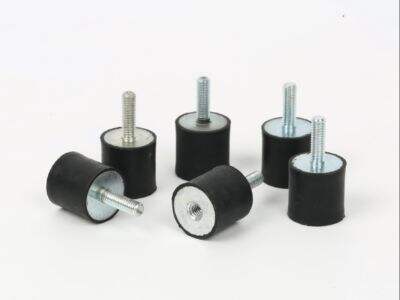Rubber mounts are everywhere — they relieve vibration in all kinds of places to make them more stable and less noisy. At first glance, they might seem simple, but there is a great deal of fascinating science at work with them. Let's explore deeper the world of rubber mounts by KFT and understand their incredible functions in simple terms.
What Are Rubber Blocks Made Of?
There are basically two materials used during the production of rubber mounts, metal and rubber or afterwards referred to as elastomers. The metal part is crucial as it provides support and structure to the mount, ensuring that it remains robust. The rubber part is unique because it can cushion shocks and vibrations. When a heavy object is in motion or vibrating, rubber mounts function like a sponge: absorbing all of the bounce and keeping everything calm and steady. And this helps keep things from going to crazy in either direction and that is an important aspect for the sake of safety and comfort.
How Rubber Mounts Save the Day When Things Get Shaken?
Ever seen a car bouncing all over the place on a bad road? That can be quite ucomfortable. Here is where vibration rubber mount are utilized. They are the ones that absorb all of the bumps and vibrations of driving down a road to make your ride a lot smoother and enjoyable. Rubber mounts are an extremely essential component in any scenario — right from cars to machines to high-rise buildings. They do a lot to make sure everything stays steady and helps reduce the amount of shaking and noise, which goes a long way in making life so much easier for all of the people inside.
What Are Elastomers?
A special types of rubber, elastomers can bend and stretch without breaking. Think of this as the squishy bit of a stress ball — it absorbs the pressure and tension when you squeeze it. With rubber mounts, the same elastomers convert the energy from vibrations to heat. This process quiets the motion and helps avoid too much shaking. The anti vibration rubber mount under your table is an elastomer too.
Rubber Mounts: How They Quiet Things Down
This is similar to if you dropped a bouncy ball on the floor. So it would bounce around everywhere and it would make a lot of noise right? But now, think of that bouncy ball encased in thick rubber. The rubber absorbs impact and dampens sound, so when you drop it, it’s quieter and less bouncy. That is exactly how rubber mounts work. It serves as a cushion between the two moving parts, absorbing rotational forces (torque) and vibration, while also helping to dampen sound levels. Think of it as like a polite bouncer who keeps all the noise quiet and prevents chaos so everyone will be happier.
So how do engineers go about conceptualizing and designing rubber mounts?
Engineers are builders or architects who use science and math to make lots of things we use every day. Engineers know a lot about materials and forces, and apply that knowledge when designing rubber mounts for strength and reliability. They examine the effects of vibrations and shocks on various types of machines and structures. Knowing how these forces work, they can design rubber mounts that are tailored to specific requirements. From cars to airplanes to playground equipment, rubber mounts are engineered to keep them stable while providing comfort for all users.
In Conclusion
Rubber mounts are not the most exciting rubber and metal bits one can imagine, but play vital roles in keeping things steady or quiet in our lives. These mounts, equipped with elastomers, are designed to cushion shocks, damp vibrations, and cut down on noise. Rubber mounts are applicable in many different areas, giving us a smoother and more peaceful experience, thanks to the smart engineering around their design. So the next time you encounter a rubber mount, think of all the awesome science that went into its trick — it's not just squishy, it's a stealthy little superhero that helps keep things running quietly and smoothly.

